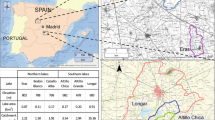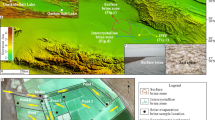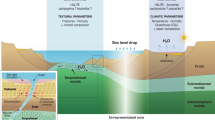Abstract
Lake Kitagata, Uganda, is a hypersaline crater lake with Na–SO4–Cl–HCO3–CO3 chemistry, high pH and relatively small amounts of SiO2. EQL/EVP, a brine evaporation equilibrium model (Risacher and Clement 2001), was used to model the major ion chemistry of the evolving brine and the order and masses of chemically precipitated sediments. Chemical sediments in a 1.6-m-long sediment core from Lake Kitagata occur as primary chemical mud (calcite, magadiite [NaSi7O13(OH)3·3H2O], burkeite [Na6(CO3)(SO4)2]) and as diagenetic intrasediment growths (mirabilite (Na2SO4·10H2O)). Predicted mineral assemblages formed by evaporative concentration were compared with those observed in salt crusts along the shoreline and in the core from the lake center. Most simulations match closely with observed natural assemblages. The dominant inflow water, groundwater, plays a significant role in driving the chemical evolution of Lake Kitagata water and mineral precipitation sequences. Simulated evaporation of Lake Kitagata waters cannot, however, explain the large masses of magadiite found in cores and the formation of burkeite earlier in the evaporation sequence than predicted. The masses and timing of formation of magadiite and burkeite may be explained by past groundwater inflow with higher alkalinity and SiO2 concentrations than exist today.





Similar content being viewed by others
References
Arad A, Morton WH (1969) Mineral springs and saline lakes of the western rift valley, Uganda. Geochim Cosmochim Acta 33:1169–1181
Deocampo DM (2004a) Authigenic clays in East Africa: regional trends and paleolimnology at the Plio-Pleistocene boundary, Olduvai Gorge, Tanzania. J Paleolimnol 31:1–9
Deocampo DM (2004b) Hydrogeochemistry in the Ngorongoro Crater, Tanzania, and implications for land use in a world heritage site. Appl Geoch 19:755–767
Deocampo DM (2005) Evaporative evolution of surface waters and the role of aqueous CO2 in magnesium silicate precipitation: Lake Eyasi and Ngorongoro Crater, northern Tanzania. S Afr J Geol 108:493–504
Deocampo DM, Cuadros J, Wing-Dudek T, Olives J, Amourek M (2009) Saline lake diagenesis as revealed by coupled mineralogy and geochemistry of multiple ultrafine clay phases: Pliocene Olduvai Gorge, Tanzania. Am J Sci 309:834–868
Eugster HP (1967) Hydrous sodium silicates from Lake Magadi, Kenya: precursors of bedded chert. Science 157:1177–1180
Eugster HP (1969) Inorganic bedded cherts from the Magadi area, Kenya. Contrib Mineral Petrol 22:1–31
Eugster HP, Jones BF (1968) Gels composed of sodium-aluminium silicate, Lake Magadi, Kenya. Science 161:160–163
Eugster HP, Jones BF (1979) Behavior of major solutes during closed-basin brine evolution. Am J Sci 279:609–631
Gunnarsson I, Arnórsson S (2000) Amorphous silica solubility and the thermodynamic properties of H4SiO°4 in the range of 0 to 350°C at Psat. Geochim Cosmochim Acta 64:2295–2307
Hay RL (1968) Chert and its sodium-silicate precursors in sodium-carbonate lakes of East Africa. Contrib Mineral Petrol 17:255–274
Hay RL, Kyser TK (2001) Chemical sedimentology and paleoenvironmental history of Lake Olduvai, a Pliocene lake in northern Tanzania. GSA Bull 113:1505–1521
Hecky RE, Kilham P (1973) Diatoms in alkaline, saline lakes: ecology and geochemical Implications. Limnol Oceanogr 18:53–71
Hover VC, Ashley GM (2003) Geochemical signatures of paleodepositional and diagenetic environments: a STEM/AEM study of authigenic clay minerals from an arid rift basin, Olduvai Gorge, Tanzania. Clays Clay Miner 51:231–251
Jones BF, Deocampo DM (2003) Geochemistry of saline lakes. In: Drever JI (ed) Surface and ground water, weathering, erosion, and soils. Treatise Geochem 5:393–424
Jones BF, Rettig SL, Eugster HP (1967) Silica in alkaline brines. Science 158:1310–1314
Jones BF, Eugster HP, Rettig SL (1977) Hydrochemistry of the Lake Magadi basin, Kenya. Geochim Cosmochim Acta 41:53–72
Kilham P (1982) The effect of hippopotamuses on potassium and phosphate ion concentrations in an African Lake. Am Midl Nat 108:202–205
Kling GW (1988) Comparative transparency, depth of mixing, and stability of stratification in lakes of Cameroon, West Africa. Limnol Oceanogr 33:27–40
Lærdal T, Talbot MR (2002) Basin neotectonics of Lakes Edward and George, East African Rift. Palaeogeogr Palaeoclimatol Palaeoecol 187:213–232
MacIntyre S, Melack JM (1982) Meromixis in an equatorial African soda lake. Limnol Oceanogr 27:595–609
Melack JM (1978) Morphometric, physical and chemical features of the volcanic crater lakes of western Uganda. Arch Hydrobiol 84:430–453
Muraishi H (1995) Experimental study of amorphous silica crystallization in Na2CO3–NaHCO3 solutions as a source of chert formation in Lake Magadi. Bull Chem Soc Jpn 68:3027–3033
Renaut RW, Tiercelin JJ (1994) Lake Bogoria, Kenya rift valley: a sedimentological overview. In: Renaut RW, Last WM (eds) Sedimentology and geochemistry of modern and ancient saline lakes, vol 50. Spec. Publ. Soc. Sediment. Geol. (SEPM), Tulsa, Okla, pp 101–123
Risacher F, Clement A (2001) A computer program for the simulation of evaporation of natural waters to high concentration. Comput Geosci 27:191–201
Russell JM, Johnson TC (2005) A high-resolution geochemical record from Lake Edward, Uganda Congo and the timing and causes of tropical African drought during the late Holocene. Quat Sci Rev 24:1375–1389
Russell JM, Johnson TC (2006) The water balance and stable isotope hydrology of Lake Edward, Uganda-Congo. J Gt Lakes Res 32:77–90
Russell JM, Verschuren D, Eggermont H (2007) Spatial complexity of “Little Ice Age” climate in East Africa: sedimentary records from two crater lake basins in western Uganda. Holocene 17:183–193
Verschuren D (1999) Influence of depth and mixing regime on sedimentation in a small, fluctuating tropical soda Lake. Limnol Oceanogr 44:1103–1113
Acknowledgments
This research was supported by the Program for Changjiang Scholars and Innovative Research Team in University (Grant No. IRT0412) and China Postdoctoral Science Foundation funded project (Grant No. 20080430472). Dan Deocampo’s review led to major improvements in the revised manuscript.
Author information
Authors and Affiliations
Corresponding author
Rights and permissions
About this article
Cite this article
Ma, L., Lowenstein, T.K. & Russell, J.M. A Brine Evolution Model and Mineralogy of Chemical Sediments in a Volcanic Crater, Lake Kitagata, Uganda. Aquat Geochem 17, 129–140 (2011). https://doi.org/10.1007/s10498-010-9108-x
Received:
Accepted:
Published:
Issue Date:
DOI: https://doi.org/10.1007/s10498-010-9108-x




